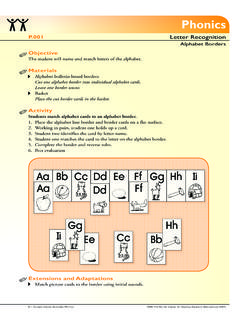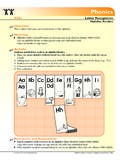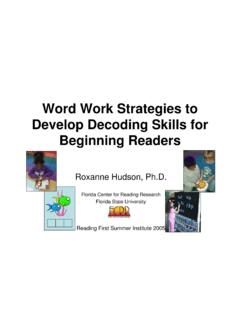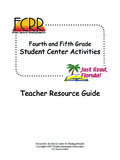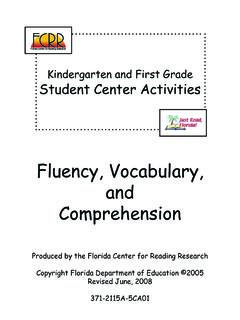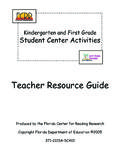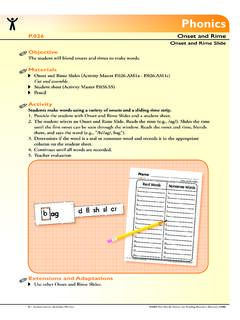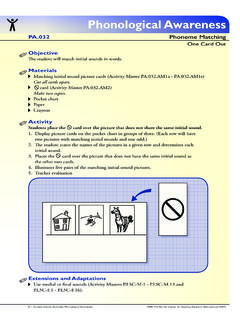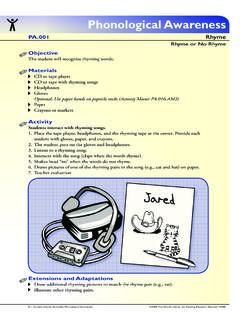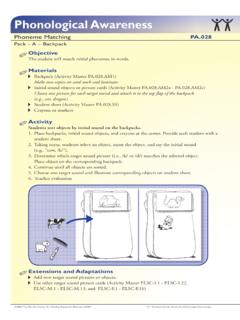Transcription of Phonological Awareness - Florida State University
1 Phonological Awareness2005 The Florida center for reading research (Revised July, 2007) K-1 Student center Activities: Phonological SegmentationNursery RhymesObjectiveThe student will segment sentences into words. MaterialsNursery rhyme cards (Activity Master - )BlocksActivityStudents count the words in sentences and stack blocks to equal the number of words counted. 1. Place nursery rhyme cards and blocks in the Student selects a nursery rhyme card, says the rhyme, and stacks the number of blocks to equal the number of words in the first sentence. For example, "Humpty Dumpty sat on a wall." There are six words in the sentence and the student stacks six blocks. 3. Places the stack of blocks on the matching picture. 4. Continues the activity choosing other nursery rhyme cards. 5. Names the card that has more words. 6. Self-checkExtensions and AdaptationsWrite a nursery rhyme other nursery rhyme cards to use in the Awareness2005 The Florida center for reading research (Revised July, 2007)K-1 Student center Activities: Phonological AwarenessNursery Awareness2005 The Florida center for reading research (Revised July, 2007) K-1 Student center Activities: Phonological RhymesPhonological Awareness2005 The Florida center for reading research (Revised July, 2007)K-1 Student center Activities: Phonological AwarenessNursery Awareness2005 The Florida center for reading research (Revised July, 2007) K-1 Student center Activities.
2 Phonological AwarenessObjectiveThe students will segment sentences into projectorStudent photographs (or boy and girl picture card - Activity Master )Copy on overhead picture cards (Activity Master )Copy on overhead transparencies, cut into individual pictures, and outline in red permanent picture cards (Activity Master - )Copy on overhead transparencies, cut into individual pictures, and outline in blue permanent marker. Silly Sentence StickMake using a pencil and a decorative make silly sentences on the overhead projector. 1. Place student photographs, picture cards, and the overhead in the center . 2. Student chooses his photograph, an action picture card (red), and a naming picture card (blue).3. Places pictures in sequence to form a silly sentence (picture card, red card, blue card).4. Taps the number of words in the sentence using the Silly Sentence Stick."5. Continues the Self-checkSentence SegmentationOverhead Silly and AdaptationsWrite and illustrate a silly sentencesPhonological Awareness2005 The Florida center for reading research (Revised July, 2007)K-1 Student center Activities: Phonological AwarenessOverhead Silly , touch, smell, hear, tastePhonological Awareness2005 The Florida center for reading research (Revised July, 2007) K-1 Student center Activities: Phonological , fish, bubbles, elephants, bears, lizardsOverhead Silly SentencesPhonological Awareness2005 The Florida center for reading research (Revised July, 2007)K-1 Student center Activities: Phonological AwarenessOverhead Silly , flowers, bananas, porcupine.
3 Substitute boy and girl pictures for AwarenessK-1 Student center Activities: Phonological Awareness2005 The Florida center for reading research (Revised July, 2007) Extensions and AdaptationsMake additional sentences to use in the sentences to play the student will segment sentences into Game board (Activity Master - )Copy on card stock and assemble the game (Activity Master )Cut into this activity, the students are not reading the words. They are using the words as units and using the spaces between them to identify the number of pieces ( , counters)ActivityStudents play a game counting words in sentences . 1. Place the game board and sentence strips face down in a stack on a flat surface. Place game pieces at START on the Taking turns, students select the top sentence strip and count the Move the game piece as many spaces as there are words in the Place sentence strip at the bottom of the stack to be used Continue until all students are at the END of the game Peer SegmentationSentence GamePhonological Awareness2005 The Florida center for reading research (Revised July, 2007)K-1 Student center Activities: Phonological GamePhonological Awareness2005 The Florida center for reading research (Revised July, 2007) K-1 Student center Activities: Phonological GamePhonological Awareness2005 The Florida center for reading research (Revised July, 2007)K-1 Student center Activities: Phonological GamePhonological Awareness2005 The Florida center for reading research (Revised July, 2007) K-1 Student center Activities.
4 Phonological AwarenessObjectiveThe student will segment sentences into by 18 construction paper Write a different number at the top of each resources ( , newspapers, magazines, or pages from old nursery rhyme books)In this activity, the students are not reading the words. They are using the words as units and using the spaces between them to identify the number of cut sentences from print resources and glue to the corresponding Place the print resources, construction paper, scissors, and glue on a flat Student cuts sentences from the print Counts the words in a sentence and glues the sentence under the corresponding number on the Continues until all the sentences are sorted and glued. 5. Teacher evaluationSentence SegmentationNewspaper Sentence and AdaptationsSort sentences by the total number of Awareness2005 The Florida center for reading research (Revised July, 2007)K-1 Student center Activities: Phonological AwarenessObjective The student will segment sentences into (Activity Master - ) Cut into stripsIn this activity the students are not reading the words.
5 They are using the words as units and using the spaces between them to identify the number of cups or containersNumber cups or containers individually with numerals ( , 4, 5, 6, 7, 8, 9, 10).ActivityStudents sort sentences by the number of words. 1. Place numbered cups and stack of sentence strips on a flat Student selects a sentence and counts the Accordion folds the sentence between the words, and places it in the cup with the corresponding number. For example, the sentence I like ice cream would be folded and placed in the cup labeled 4."4. Teacher evaluationSentence SegmentationCrinkle CreepersExtensions and AdaptationsMake other the sentences to each the sentences by the number of Awareness2005 The Florida center for reading research (Revised July, 2007) K-1 Student center Activities: Phonological AwarenessCrinkle Awareness2005 The Florida center for reading research (Revised July, 2007)K-1 Student center Activities: Phonological AwarenessCrinkle Awareness2005 The Florida center for reading research (Revised July, 2007) K-1 Student center Activities: Phonological AwarenessCrinkle Awareness2005 The Florida center for reading research (Revised July, 2007)K-1 Student center Activities: Phonological AwarenessSentence SegmentationSentence student will segment sentences into graph student sheet (Activity Master )Big Book(s)In this activity the students are not reading the words.
6 They are using the words as units and using the spaces between them to identify the number of count and graph words from sentences in a Big Place Big Book(s) in the center . Provide each student with a student The student looks at the first sentence in a Big Book and counts the number of words in the sentence. 3. Shades in a box under the number which corresponds to the number of words in the sentence. 4. Continues until all the sentences in the book are Teacher evaluationExtensions and AdaptationsSort sentences by the total number of sentences by the total number of other graphs (Activity Master ).2005 The Florida center for reading research (Revised July, 2007) K-1 Student center Activities: Phonological AwarenessNameSentence Student center Activities: Phonological Awareness2005 The Florida center for reading research (Revised July, 2007)NameSentence Awareness2005 The Florida center for reading research (Revised July, 2007) K-1 Student center Activities: Phonological AwarenessSyllables SegmentingClapping student will segment syllables in words.
7 MaterialsStudent photographs Copy student school box or trayOrganize photographs in craft box or place on work boards (Activity Master )Copy, cut, and sheet (Activity Master ) Unifix cubesClapping hands (Activity Master )Copy twice, cut out, attach to popsicle sticks, and clap the syllables in names, place the corresponding number of cubes on the syllable work boards, and record on the student Place student photographs, syllable work boards, unifix cubes, and clapping hands at the center . Provide each student with a student Taking turns, each student names a classmate, finds the classmate's photograph, and places it on his board. 3. Uses the "clapping hands" to count the syllables in the name and places the corresponding number of cubes in the boxes under the Removes the cubes from the boxes, coloring each box on the student sheet as the cube is Moves the photograph to the student sheet, glues the photograph on the sheet, and says the Continues the activity until the student sheet is Teacher evaluationExtensions and AdaptationsList student student photographs on student sheet (Activity Master ) and color the boxes (no cubes).
8 K-1 Student center Activities: Phonological Awareness2005 The Florida center for reading research (Revised July, 2007)NameClapping Awareness2005 The Florida center for reading research (Revised July, 2007) K-1 Student center Activities: Phonological AwarenessClapping Awareness2005 The Florida center for reading research (Revised July, 2007)K-1 Student center Activities: Phonological AwarenessClapping Awareness2005 The Florida center for reading research (Revised July, 2007) K-1 Student center Activities: Phonological AwarenessObjectiveThe student will segment syllables in words. MaterialsTwo-to-four syllable picture cards (Activity Master - )Shoeboxes or containersAttach picture cards found on ( , lion, octopus, alligator) to three picture cards in the count the syllables in words and place cards in the corresponding Place the shoeboxes and basket of cards on a flat surface.
9 2. Taking turns, students choose a picture card from the basket, say the word, and clap the Feed the picture card to the hungry animal with the same number of syllables ( , place the picture of the lettuce in the lion box).4. Continue until all the picture cards are fed to the animals. 5. Peer evaluationSyllables SegmentingFeed the and AdaptationsMake other two-to-four syllable picture Awareness2005 The Florida center for reading research (Revised July, 2007)K-1 Student center Activities: Phonological the Animalspretzel-2, candy-2, cookies-2, turkey-2, apple-2, lettuce-2 Phonological Awareness2005 The Florida center for reading research (Revised July, 2007) K-1 Student center Activities: Phonological AwarenessFeed the Animalscarrot-2, cereal-3, cantaloupe-3, lemonade-3, lollipop-3, Awareness2005 The Florida center for reading research (Revised July, 2007)K-1 Student center Activities: Phonological Awarenessbanana-3, hamburger-3, tomato-3, potato-3, watermelon-4, the AnimalsPhonological Awareness2005 The Florida center for reading research (Revised July, 2007) K-1 Student center Activities.
10 Phonological Awarenesscauliflower-4, pepperoni-4, lion-2, octopus-3, alligator-4 Feed the Awareness2005 The Florida center for reading research (Revised July, 2007)K-1 Student center Activities: Phonological AwarenessObjectiveThe student will segment syllables in board Use a hopscotch mat, tape off a hopscotch board, or draw with sidewalk syllable picture cards (Activity Master - )ActivityStudents hop the number of syllables in a Place the hopscotch board on the floor and stack the cards Taking turns, student one flips over the first card from the stack of picture cards, says the name of the picture, segments the word, and counts the number of syllables. 3. Student two hops to the corresponding number while segmenting the Reverse roles and continue Peer evaluationExtensions and AdaptationsPlay hopscotch, counting the phonemes in other syllable picture SegmentingSyllable "Ham-bur-ger" Phonological Awareness2005 The Florida center for reading research (Revised July, 2007) K-1 Student center Activities: Phonological Awarenessking-1, fork-1, lock-1, top-1, soap-1, HopscotchPhonological Awareness2005 The Florida center for reading research (Revised July, 2007)K-1 Student center Activities: Phonological Awarenessstapler-2, pocket-2, bacon-2, caboose-2, spaghetti-3, popsicle-3 Syllable Awareness2005 The Florida center for reading research (Revised July, 2007) K-1 Student center Activities.
